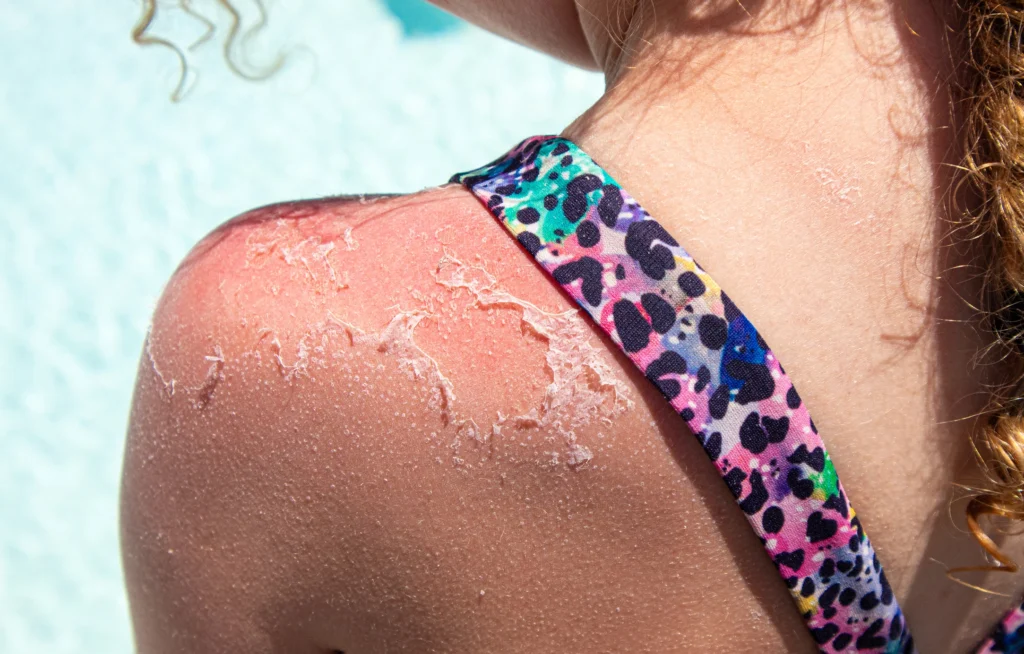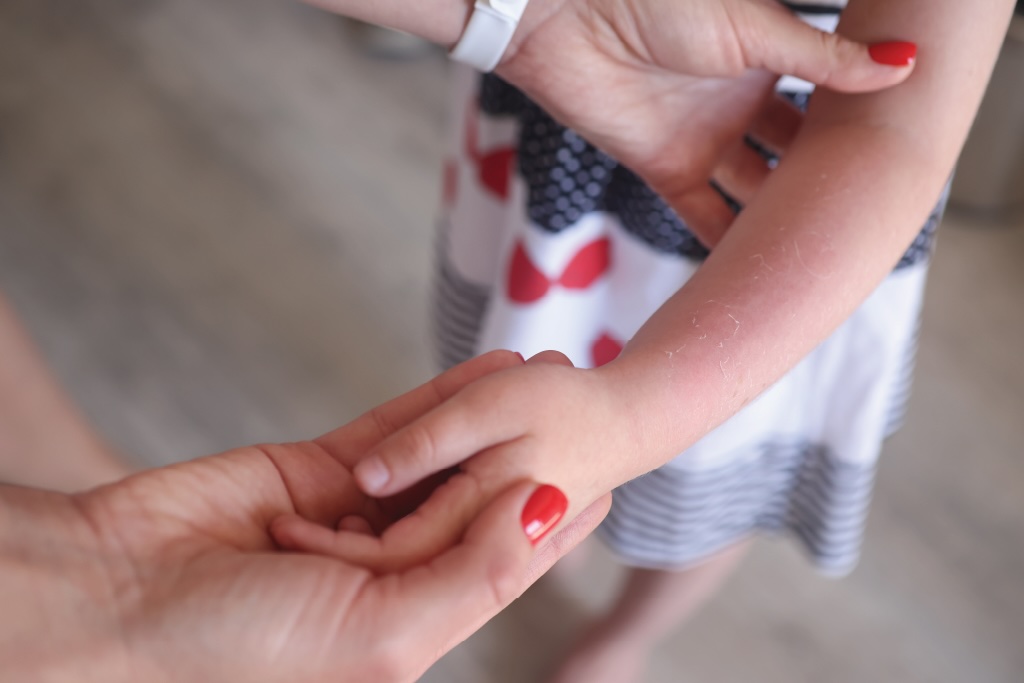As we plan beach trips intending to soak up the summer sun, it’s vital to prioritize the health of our skin. While we all know sunburns are a consequence of extended sun exposure, there are other repercussions to be aware of: heat rash and sun poisoning. Understanding the differences between these two conditions is crucial for proper treatment and prevention. In this blog, we will explore the distinctive characteristics of heat rash and sun poisoning and equip you with the knowledge to identify and address both skin issues. Let’s embark on this informative journey on how to safeguard our skin during the summer months when everyone wants to soak up those warm UV rays from the sun.
What is Heat Rash?
Heat rash, also known as miliaria or prickly skin, is a condition that can occur when sweat ducts become blocked, and sweat cannot reach the skin’s surface to evaporate. As a result, it leads to skin inflammation and other symptoms. This type of rash occurs in areas where clothes can cause friction with your skin, such as your armpits or in the creases of your elbow.
Heat rash is often confused with polymorphic light eruption or a sun rash, where someone with sunlight sensitivity develops a rash due to direct sun exposure. With a heat rash, they usually occur in places where the skin is covered. There are a few different circumstances that can cause a heat rash to develop, which include the following:

Hot and Humid Weather
High temperatures and humidity in the air can increase our body’s sweat production. When sweat can’t evaporate due to blocked sweat ducts and our sweat becomes trapped under the skin, it can lead to heat rash.
Physical Activity
Excessive sweating can occur during intense physical activity or exercise in hot conditions. As a result, our sweat ducts can become overwhelmed and lead to heat rash.
Synthetic or Tight Clothing
Wearing tight or synthetic clothing can trap heat and moisture against the skin, impairing sweat evaporation and increasing the likelihood of heat rash.
Overheating
Prolonged exposure to high temperatures, such as staying in a hot environment without adequate ventilation or air conditioning, can lead to excessive sweating and subsequent heat rash.
Heat Rash Symptoms and Treatment
Heat rash manifests through distinct symptoms and requires specific treatment measures for relief. The symptoms of heat rash typically include:
- Small red bumps
- Itching
- Stinging sensation on the affected area
To treat heat rash and relieve symptoms, the first step is to create a cool and dry environment. This can be achieved by staying in air-conditioned spaces, using fans, or taking a cool bath or shower. In most cases, Additional steps to take include:
- Wearing loose, breathable clothing
- Applying anti-itch cream or lotion
- Avoid scratching to prevent infection
- Stay hydrated
In most cases, heat rash resolves on its own with the self-care measures mentioned above. However, if the symptoms persist or worsen, seeking medical attention is recommended for proper diagnosis and treatment.

What is Sun Poisoning?
Sun poisoning, also known as severe sunburn, is a serious skin condition that occurs due to prolonged and intense sun exposure. Unlike mild sunburn, sun poisoning affects not only the surface of the skin but can also cause other symptoms throughout the body. The primary cause of sun poisoning is insufficient sun protection, such as inadequate use of sunscreen, being exposed to sunlight for prolonged periods of time without seeking shade, or not wearing protective clothing. The symptoms of sun poisoning include:
- Severe redness
- Pain
- Swelling
- Blistering
- Peeling of the skin
In more severe cases, individuals may experience additional symptoms, including:
- Fever
- Chills
- Nausea
- Dehydration
Recognizing the signs of sun poisoning and seeking medical attention promptly to prevent complications and receive appropriate treatment is crucial.
How to Treat and Avoid Sun Poisoning
Sun poisoning requires some safety measures to avoid future occurrences. You can avoid sun poisoning by following these safety tips and precautions:
- Applying and reapplying sunscreen
- Wearing a wide-brimmed hat or other protective clothing
- Take breaks in the shade or indoors
- Avoid the sun during peak sun hours
- Take breaks in the shade
- Stay hydrated
Treating sun poisoning involves limiting sun exposure and other self-care measures, including:
- Stay hydrated
- Moisturize skin with aloe vera
- Use steroid creams
- Taking oral antihistamines and other pain relievers
- Use cool compresses
- Take cool baths or showers
- Avoid itching or peeling the affected skin
The recovery time for healing from sun poisoning can vary depending on the individual and the severity of the sunburn. Still, if the self-care tips mentioned above are followed, the skin should heal completely within a few weeks. If symptoms worsen or don’t improve within a few weeks, consulting your healthcare provider is recommended. Repeated episodes of sun poisoning can lead to long-term skin damage and other lasting effects, such as an increased risk of skin cancer. Therefore, it is essential to practice caution and partake in protection measures to prevent future occurrences and maintain the health of your skin.

Differentiating Heat Rash & Sun Poisoning
To summarize, heat rash vs sun poisoning have a few key differences. Heat rash develops when the sweat our body produces cannot evaporate due to being trapped beneath the skin. It will appear as a rash on some parts of your body and can clear up in a few days or a couple of weeks when self-care measures (like wearing loose clothing) are followed.
On the other hand, sun poisoning is often referred to as severe sunburn, meaning it occurs due to prolonged sun exposure. Depending on the severity of the sunburn, it can take several weeks for your skin to fully recover, but not without long-term damage. Sun poisoning can make your skin appear bright red, swollen, and blistered and will appear on any part of your body that has had prolonged exposure to the sun.
People often know when they’re sunburned because they’re aware of the redness that comes as a result, but heat rash is typically unexpected since it doesn’t develop on sun-exposed skin but on covered skin. Sun poisoning can be very painful and occur all over your body, while a heat rash can be itchy or irritating and usually occurs in small areas of the body.
Skin Care Treatment at Austin Emergency Center
While most cases of sun poisoning or heat rash can be managed at home, there are certain situations where we recommend seeking medical attention. If you’re experiencing severe blistering or pain, showing signs of dehydration, or having difficulty breathing, please seek emergency medical care.
If you are in the Austin area and require emergency care, Austin Emergency Center is always open to provide comprehensive emergency medical services. With their experienced healthcare professionals and state-of-the-art facilities, they can assess the severity of your condition, offer appropriate treatments such as pain management and wound care, and provide necessary guidance for your recovery. When it comes to experiencing severe symptoms of sun poisoning or heat rash, your health and well-being are of utmost importance, and visiting a trusted emergency center like Austin Emergency Center can provide the medical care you need.

